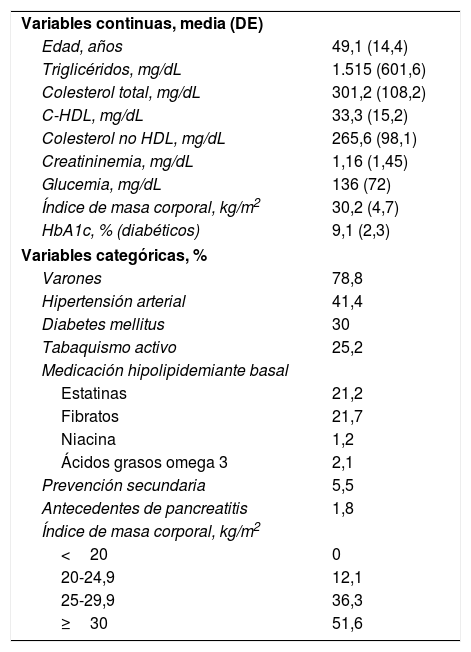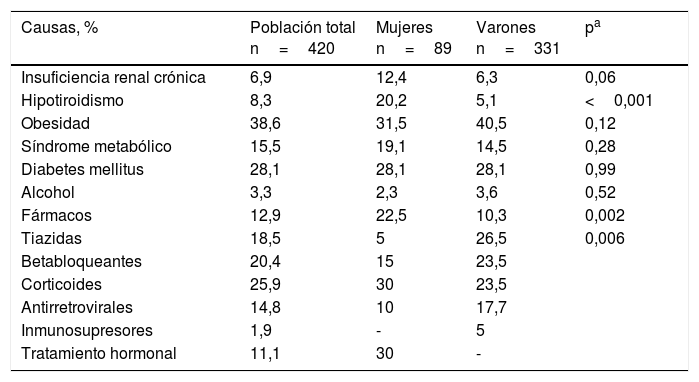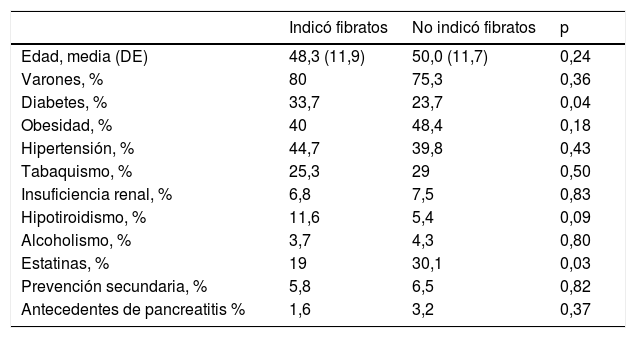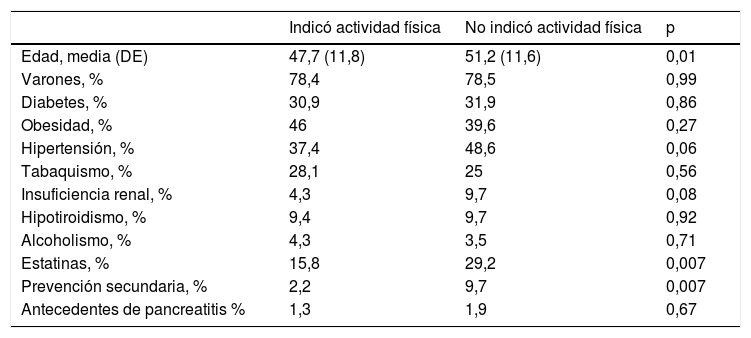El manejo terapéutico de la hipertrigliceridemia grave representa un desafío clínico.
Objetivos1) Identificar las características clínicas de los pacientes con hipertrigliceridemia grave; 2) Analizar el tratamiento instaurado por el médico en cada caso.
MétodosSe realizó un estudio de corte transversal a partir de la historia clínica electrónica. Se incluyeron todos los pacientes>18 años con una determinación en sangre de triglicéridos≥1.000mg/dL entre el 01/01/2011 y el 31/12/2016. Se identificaron variables clínicas y de laboratorio. Se analizó la conducta de los médicos tratantes en los 6 meses posteriores al hallazgo lipídico.
ResultadosSe incluyeron 420 pacientes (edad media 49,1±11,4 años, varones el 78,8%). La mediana de triglicéridos fue 1.329mg/dL (rango intercuartílico 1.174-1.658). En el 34,1% de los pacientes no se encontraron causas secundarias. Las causas secundarias más frecuentes fueron la obesidad (38,6%) y la diabetes (28,1%). Se recomendó realizar actividad física y se derivó a un nutricionista en el 49,1% y el 44,2% de los pacientes respectivamente. Las causas secundarias se identificaron y se intentaron corregir en el 40,7% de los casos. Los esquemas terapéuticos más indicados fueron fenofibrato 200mg/día (26,5%) y gemfibrozil 900mg/día (19,3%). Pocos pacientes recibieron la indicación de ácidos grasos omega 3 o niacina.
ConclusiónNuestro trabajo mostró por primera vez en nuestro país las características de una población con hipertrigliceridemia grave. Las medidas terapéuticas instauradas por los médicos fueron insuficientes. Conocer las características en este particular escenario clínico podría mejorar el abordaje actual de estos pacientes.
The therapeutic management of severe hypertriglyceridaemia represents a clinical challenge.
ObjectivesThe objectives of this study were 1) to identify the clinical characteristics of patients with severe hypertriglyceridaemia, and 2) to analyse the treatment established by the physicians in each case.
MethodsA cross-sectional study was carried out using the computerised medical records of all patients>18 years of age with a blood triglyceride level≥1,000mg/dL between 1 January 2011 and 31 December 2016. Clinical and laboratory variables were collected. The behaviour of the physicians in the 6 months after the lipid finding was analysed.
ResultsA total of 420 patients were included (mean age 49.1±11.4 years, males 78.8%). The median of triglycerides was 1,329mg/dL (interquartile range 1,174-1,658). No secondary causes were found in 34.1% of the patients. The most frequent secondary causes were obesity (38.6%) and diabetes (28.1%). Physical activity was recommended and a nutritionist was referred to in 49.1% and 44.2% of the patients, respectively. Secondary causes were identified and attempts were made to correct them in 40.7% of cases. The most indicated pharmacological treatments were fenofibrate 200mg/day (26.5%) and gemfibrozil 900mg/day (19.3%). Few patients received the indication of omega 3 fatty acids or niacin.
ConclusionThis study showed, for the first time in our country, the characteristics of a population with severe hypertriglyceridaemia. The therapeutic measures instituted by the physicians were insufficient. Knowing the characteristics in this particular clinical scenario could improve the current approach of these patients.
Artículo
Comprando el artículo el PDF del mismo podrá ser descargado
Precio 19,34 €
Comprar ahora










